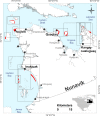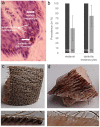Towards a Better Understanding of the Effects of UV on Atlantic Walruses, Odobenus rosmarus rosmarus: A Study Combining Histological Data with Local Ecological Knowledge
- PMID: 27049757
- PMCID: PMC4822789
- DOI: 10.1371/journal.pone.0152122
Towards a Better Understanding of the Effects of UV on Atlantic Walruses, Odobenus rosmarus rosmarus: A Study Combining Histological Data with Local Ecological Knowledge
Abstract
Walruses, Odobenus rosmarus, play a key role in the Arctic ecosystem, including northern Indigenous communities, which are reliant upon walruses for aspects of their diet and culture. However, walruses face varied environmental threats including rising sea-water temperatures and decreasing ice cover. An underappreciated threat may be the large amount of solar ultraviolet radiation (UV) that continues to reach the Arctic as a result of ozone loss. UV has been shown to negatively affect whales. Like whales, walrus skin is unprotected by fur, but in contrast, walruses spend long periods of time hauled-out on land. In this study, we combined the results of histological analyses of skin sections from five Atlantic walruses, Odobenus rosmarus rosmarus, collected in Nunavik (Northern Quebec, Canada) with qualitative data obtained through the interviews of 33 local walrus hunters and Inuit Elders. Histological analyses allowed us to explore UV-induced cellular lesions and interviews with experienced walrus hunters and Elders helped us to study the incidences and temporal changes of UV-induced gross lesions in walruses. At the microscopic scale, we detected a range of skin abnormalities consistent with UV damage. However, currently such UV effects do not seem to be widely observed at the whole-animal level (i.e., absence of skin blistering, erythema, eye cataract) by individuals interviewed. Although walruses may experience skin damage under normal everyday UV exposure, the long-term data from local walrus hunters and Inuit Elders did not report a relation between the increased sun radiation secondary to ozone loss and walrus health.
Conflict of interest statement
Figures




Similar articles
-
New migration and distribution patterns of Atlantic walruses (Odobenus rosmarus rosmarus) around Nunavik (Québec, Canada) identified using Inuit Knowledge.Polar Biol. 2021;44(9):1833-1845. doi: 10.1007/s00300-021-02920-6. Epub 2021 Aug 6. Polar Biol. 2021. PMID: 34720377 Free PMC article.
-
Towards a better understanding of the benefits and risks of country food consumption using the case of walruses in Nunavik (Northern Quebec, Canada).Sci Total Environ. 2020 Jun 1;719:137307. doi: 10.1016/j.scitotenv.2020.137307. Epub 2020 Feb 13. Sci Total Environ. 2020. PMID: 32143094
-
Population structure and gene flow of the Atlantic walrus (Odobenus rosmarus rosmarus) in the eastern Atlantic Arctic based on mitochondrial DNA and microsatellite variation.Mol Ecol. 1998 Oct;7(10):1323-36. doi: 10.1046/j.1365-294x.1998.00455.x. Mol Ecol. 1998. PMID: 9787444
-
Walrus (Odobenus rosmarus) Dentition and Tusk Extraction Techniques.Vet Clin North Am Exot Anim Pract. 2025 Sep;28(3):711-721. doi: 10.1016/j.cvex.2025.05.002. Epub 2025 Jun 27. Vet Clin North Am Exot Anim Pract. 2025. PMID: 40581577 Review.
-
The human health effects of ozone depletion and interactions with climate change.Photochem Photobiol Sci. 2011 Feb;10(2):199-225. doi: 10.1039/c0pp90044c. Epub 2011 Jan 20. Photochem Photobiol Sci. 2011. PMID: 21253670 Review.
Cited by
-
New migration and distribution patterns of Atlantic walruses (Odobenus rosmarus rosmarus) around Nunavik (Québec, Canada) identified using Inuit Knowledge.Polar Biol. 2021;44(9):1833-1845. doi: 10.1007/s00300-021-02920-6. Epub 2021 Aug 6. Polar Biol. 2021. PMID: 34720377 Free PMC article.
-
Multi-tissue DNA methylation aging clocks for sea lions, walruses and seals.Commun Biol. 2023 Apr 1;6(1):359. doi: 10.1038/s42003-023-04734-0. Commun Biol. 2023. PMID: 37005462 Free PMC article.
-
Inuit knowledge of Arctic Terns (Sterna paradisaea) and perspectives on declining abundance in southeastern Hudson Bay, Canada.PLoS One. 2020 Nov 17;15(11):e0242193. doi: 10.1371/journal.pone.0242193. eCollection 2020. PLoS One. 2020. PMID: 33201915 Free PMC article.
References
-
- Lindqvist C, Bachmann L, Andersen LW, Born EW, Arnason U, Kovacs KM, et al. The Laptev Sea walrus Odobenus rosmarus laptevi: An enigma revisited. Zool Scr. 2009;38: 113–127. 10.1111/j.1463-6409.2008.00364.x - DOI
-
- Fay F. Ecology and Biology of the Pacific Walrus, Odobenus rosmarus divergens Illiger. North Am Fauna. 1982; 279.
-
- Born EW, Andersen LW, Gjertz I, Wiig O. A review of the genetic relationships of Atlantic walrus (Odobenus rosmarus rosmarus) east and west of Greenland. Polar Biol. 2001;24: 713–718. 10.1007/s003000100277 - DOI
-
- Krupnik I, Ray GC. Pacific walruses, indigenous hunters, and climate change: Bridging scientific and indigenous knowledge. Deep Res Part II Top Stud Oceanogr. 2007;54: 2946–2957. 10.1016/j.dsr2.2007.08.011 - DOI
-
- Huntington HP, Noongwook G, Bond NA, Benter B, Snyder JA, Zhang J. The influence of wind and ice on spring walrus hunting success on St. Lawrence Island, Alaska. Deep Res Part II Top Stud Oceanogr. Elsevier; 2013;94: 312–322. 10.1016/j.dsr2.2013.03.016 - DOI
Publication types
MeSH terms
LinkOut - more resources
Full Text Sources
Other Literature Sources

